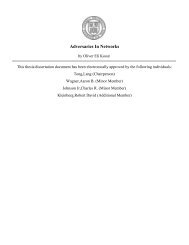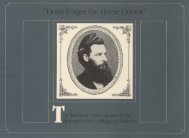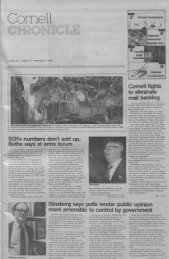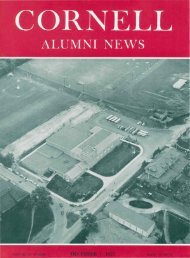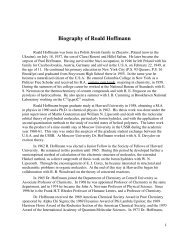Preliminary pages FINAL.pdf - eCommons@Cornell - Cornell ...
Preliminary pages FINAL.pdf - eCommons@Cornell - Cornell ...
Preliminary pages FINAL.pdf - eCommons@Cornell - Cornell ...
Create successful ePaper yourself
Turn your PDF publications into a flip-book with our unique Google optimized e-Paper software.
about the very nature, the essence of style. Does singing create style, or do style<br />
choices result in singing? How are technique and style related?<br />
These questions led to this dissertation, which addresses the relationship<br />
between singing and style on old recordings. As such, it joins a growing number of<br />
scholarly works on recordings. By studying vocal recordings in particular, however, I<br />
wish to address the discrepancy between the disproportionately large number of early<br />
recordings that featured singers, and the relatively small number of scholars that have<br />
focused on them. 4 This imbalance may exist in part because musicologists are more<br />
likely to have been trained as instrumentalists than as singers.<br />
There are, however, special challenges involved in discussing style as it relates<br />
to singing, challenges which traditional musicology is ill suited to address. In making<br />
specific claims about style on recordings, academic writers tend to focus on elements<br />
such as ornamentation, tempo, vibrato, portamento and rubato. With the possible<br />
exception of vibrato, all of these are concerned with how performance relates to a<br />
musical score, and all are relatively easy to transcribe and compare. 5 But singers<br />
make an enormous diversity of sounds, many of which are not so easily quantified.<br />
Writers in other disciplines – namely, critics and record collectors – have long relied<br />
on a rich vocabulary of metaphors to describe singing. Should musicology follow<br />
suit? How should scholars go about considering the sounds singers make?<br />
4 In the past several years, Daniel Leech-Wilkinson has turned his attention to vocal recordings – in<br />
particular, to performances of Schubert song. See “Portamento and Musical Meaning,” Journal of<br />
Musicological Research, 25 (2006): 233-261; “Expressive Gestures in Schubert Singing on Record,”<br />
Nordisk Estetisk Tidskrift 33-34 (2006): 50-70; and “Sound and Meaning in Recordings of Schubert’s<br />
‘Die junge Nonne’,” Musicae Scientiae 11 (2007): 209-36. Vocal recordings also figure prominently in<br />
Leech-Wilkinson’s forthcoming book, The Changing Sound of Music: Approaches to Studying<br />
Recorded Musical Performances (in press); I am grateful that he has shared this work with me in<br />
advance of its publication.<br />
5 See Will Crutchfield, “Vocal Ornamentation in Verdi: the Phonographic Evidence,” 19 th Century<br />
Music 7/1 (Summer 1983), 3-54; José A. Bowen, “Performers Interpreting History: Finding “‘Una voce<br />
poco fa’” (Paper presented at the annual meeting of the American Musicological Society, Toronto,<br />
Canada, November 2000); and Emanuele Senici, “Per una biografia musicale di Amina,” (paper<br />
presented at the Atti del convengo “Vincenzo Bellini: verso l’edizione critica,” Siena, Accademia,<br />
Chigiana, June 1-3, 2000).<br />
xxiii




